Homemade calendula cream is the perfect way to incorporate healing herbs into your homemade all-natural beauty and body care products! Calendula is well known for its medicinal benefits. It is a powerful medicinal herb, particularly for skin ailments and rashes. This all-natural calendula cream is an easy herbal remedy to make at home – even for beginners!
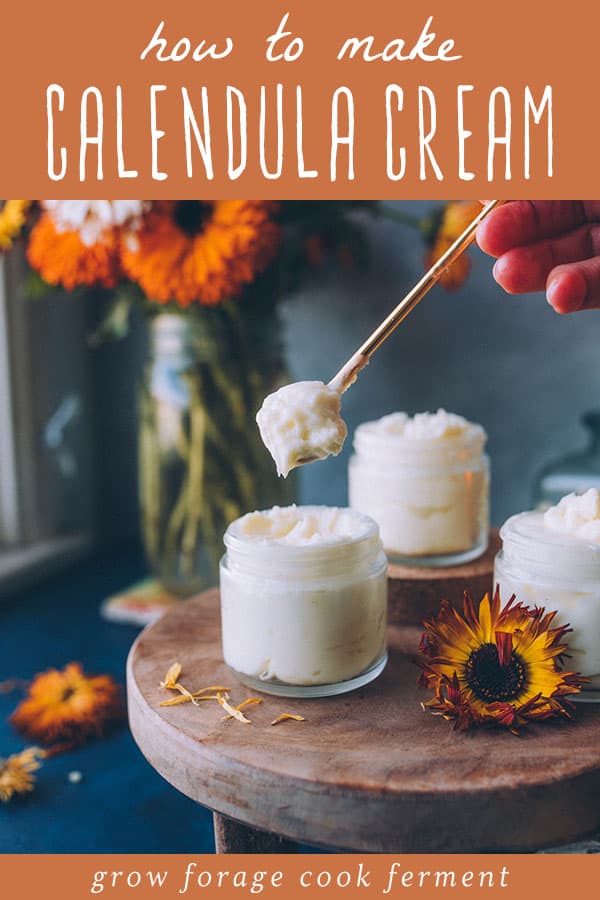
Homemade Calendula Cream
I can’t wait to tell you about this! I’m going to show you how to make homemade calendula cream. It turned out so good and is incredibly easy to make.
This calendula cream is thick and rich, almost like a body butter, and can be used like lotion or like a healing salve. In other words, it’s a perfect way to incorporate herbs into your body products!
Calendula, also called pot marigold (not to be confused with regular marigold), is well known for its healing benefits. It’s anti-inflammatory, excellent for the skin, and a powerful wound healer.
It is a potent medicinal herb, particularly for skin ailments and rashes, including eczema, acne and even diaper rash. It would also be a perfect addition to an herbal salve.
Related: 10 Ways to Use Calendula Infused Herbal Oil
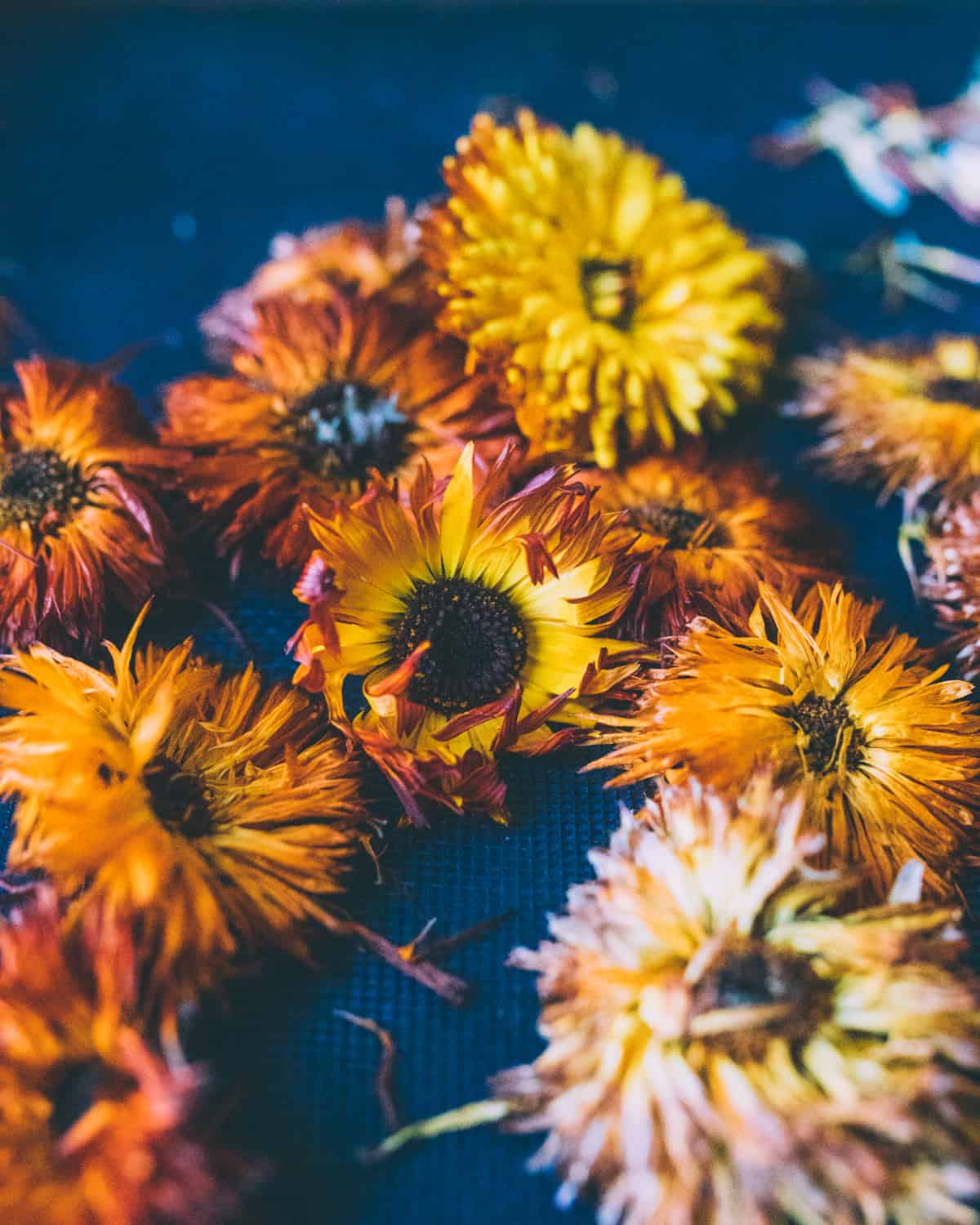
Make the Calendula Infused Oil
The first step in making this calendula cream, just like in my herbal salve recipe, is to make an infused oil.
This can be done by putting dried calendula flowers in a jar, cover with a carrier oil, and let it sit for several weeks to infuse.
You can also use the quick method of heating the oil and dried flowers in a pot on low heat for up to 12 hours.
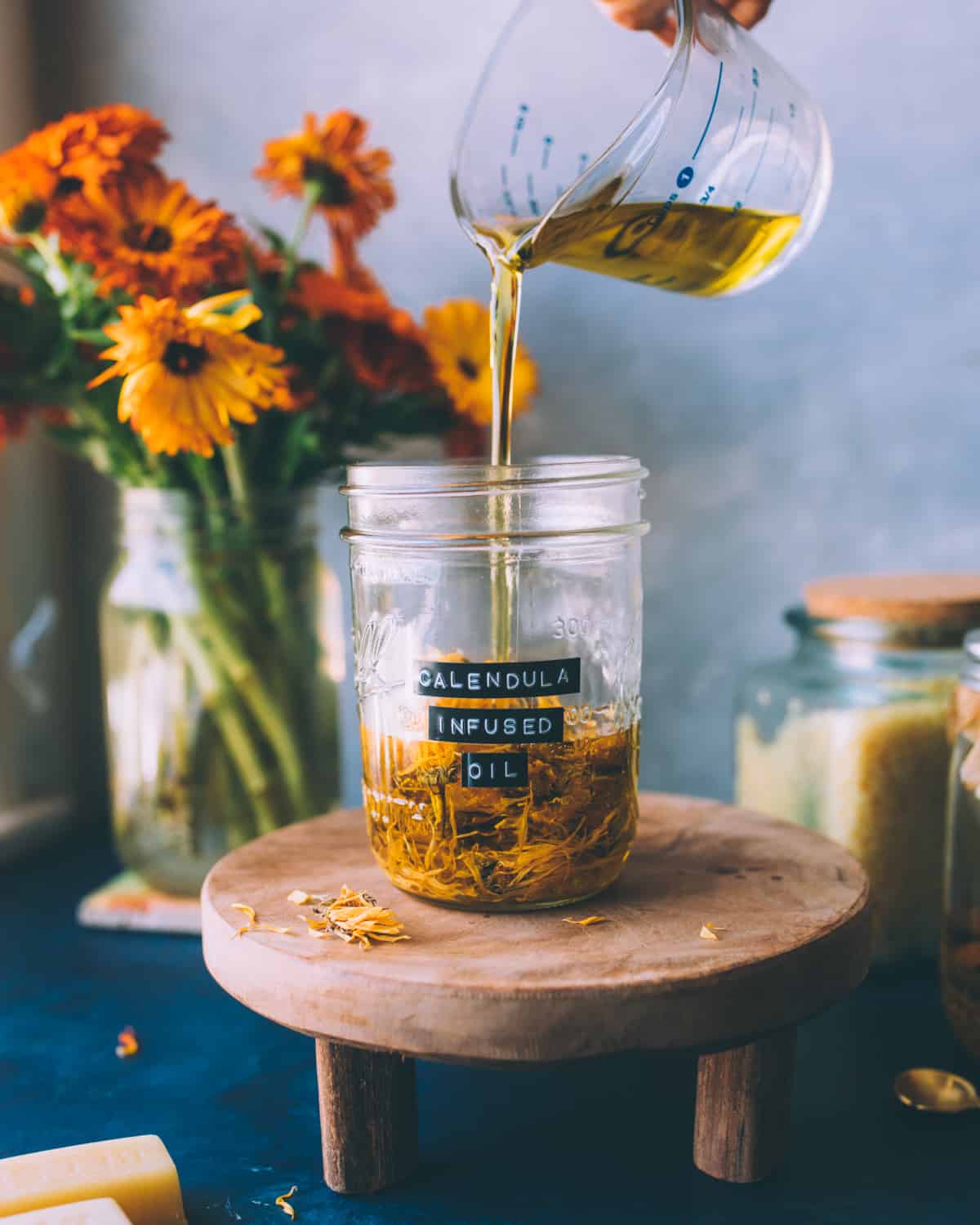
You will need 1 cup total of infused oil for this recipe, but I always figure it’s better to make more than you need so you have it ready for next time! It will keep for quite a while.
Use a ratio of 3 parts olive oil to 1 part coconut oil when making this infused oil. So, if you’re making 1 cup of oil, that means ¾ cup olive oil and ¼ cup coconut oil.
Feel free to incorporate other herbs into the infused oil if you like. Dried lavender flowers or chamomile would be great additions!
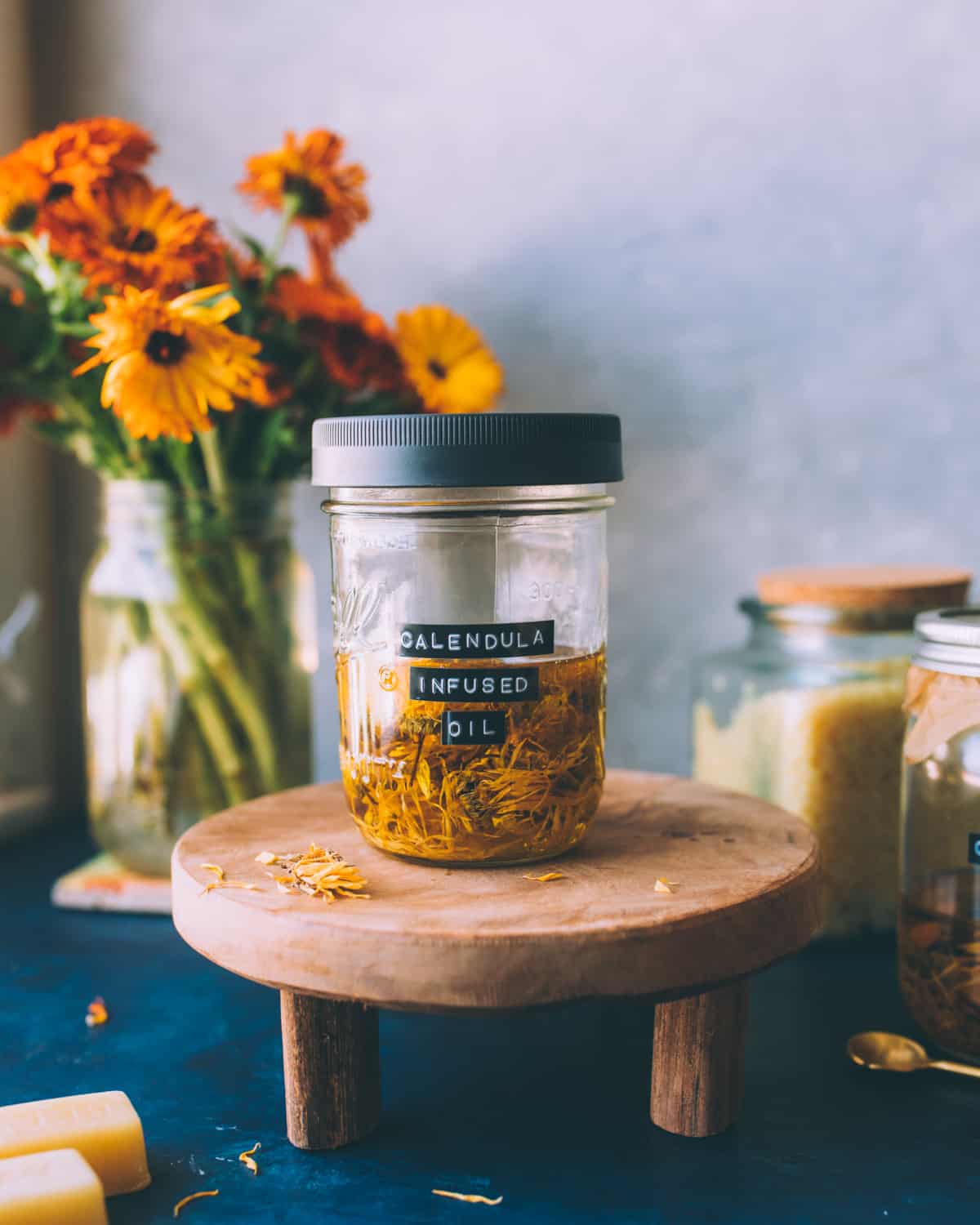
Once the calendula infused oil is made, strain out the flowers. The oil will be a nice golden yellow color.
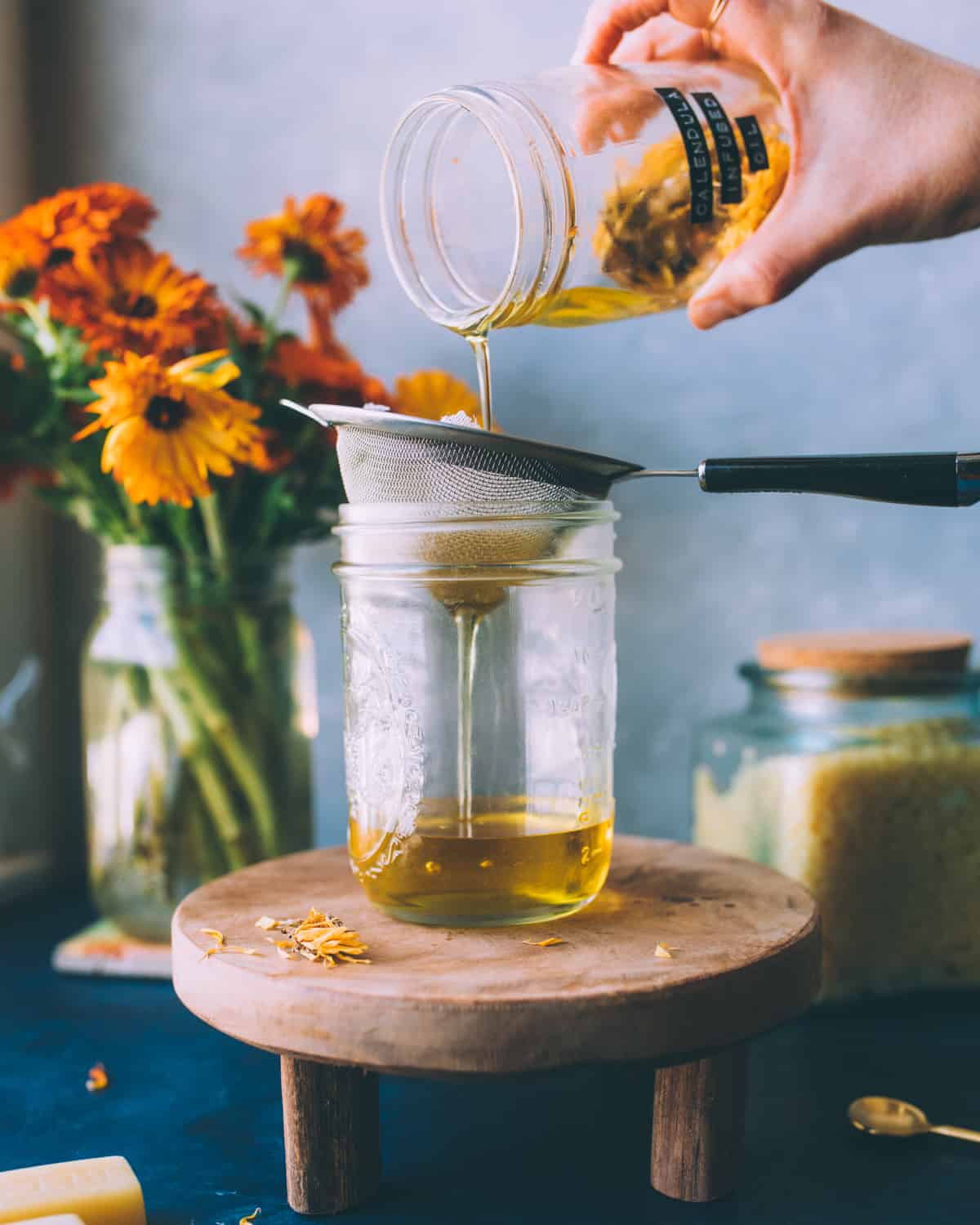
How to Make Calendula Cream
After you have made and strained the calendula oil, it’s time to make the cream.
The first thing you want to do is bring several cups of water in a pot to a boil.
Put about 2 cups of the boiling water into a blender to preheat it. This is to help keep the cream from sticking to the blender.
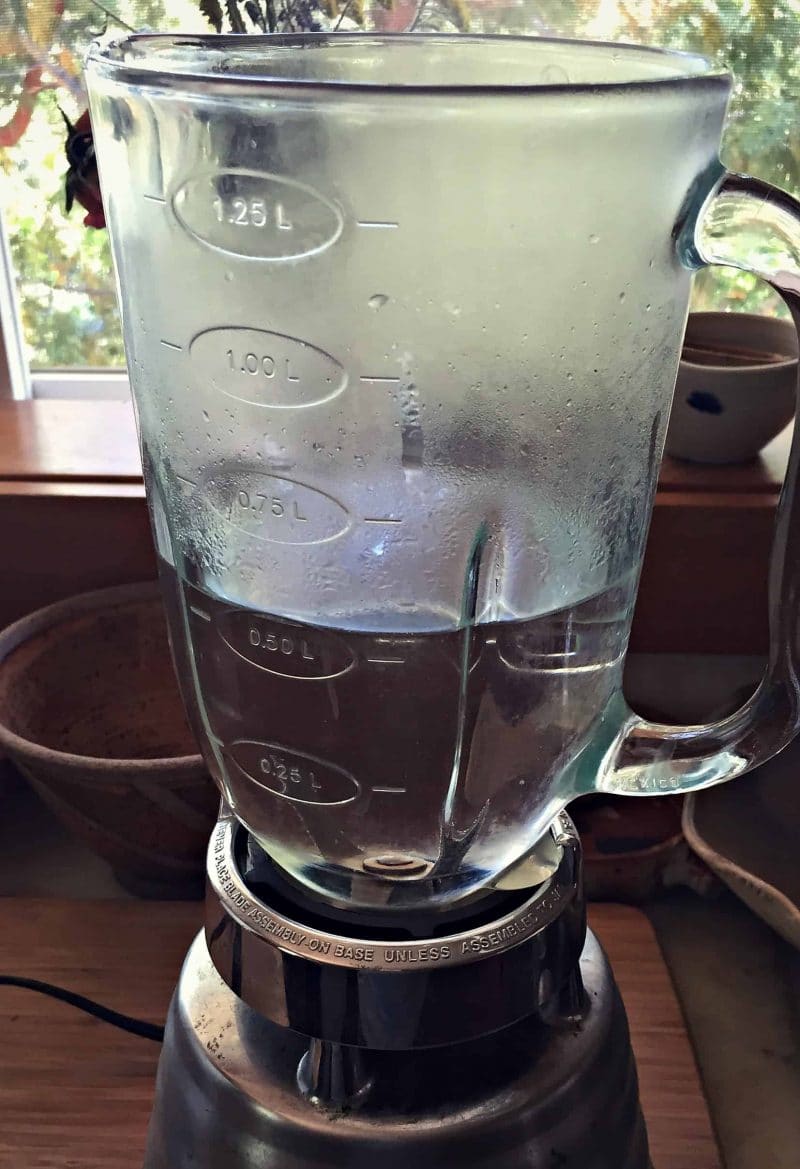
Turn the rest of the water in the pot down to a simmer and make a double boiler.
This can be done by putting the infused oil and beeswax either in a heat proof bowl on top of the pot of water, or in a glass measuring cup that you place in the simmering water.
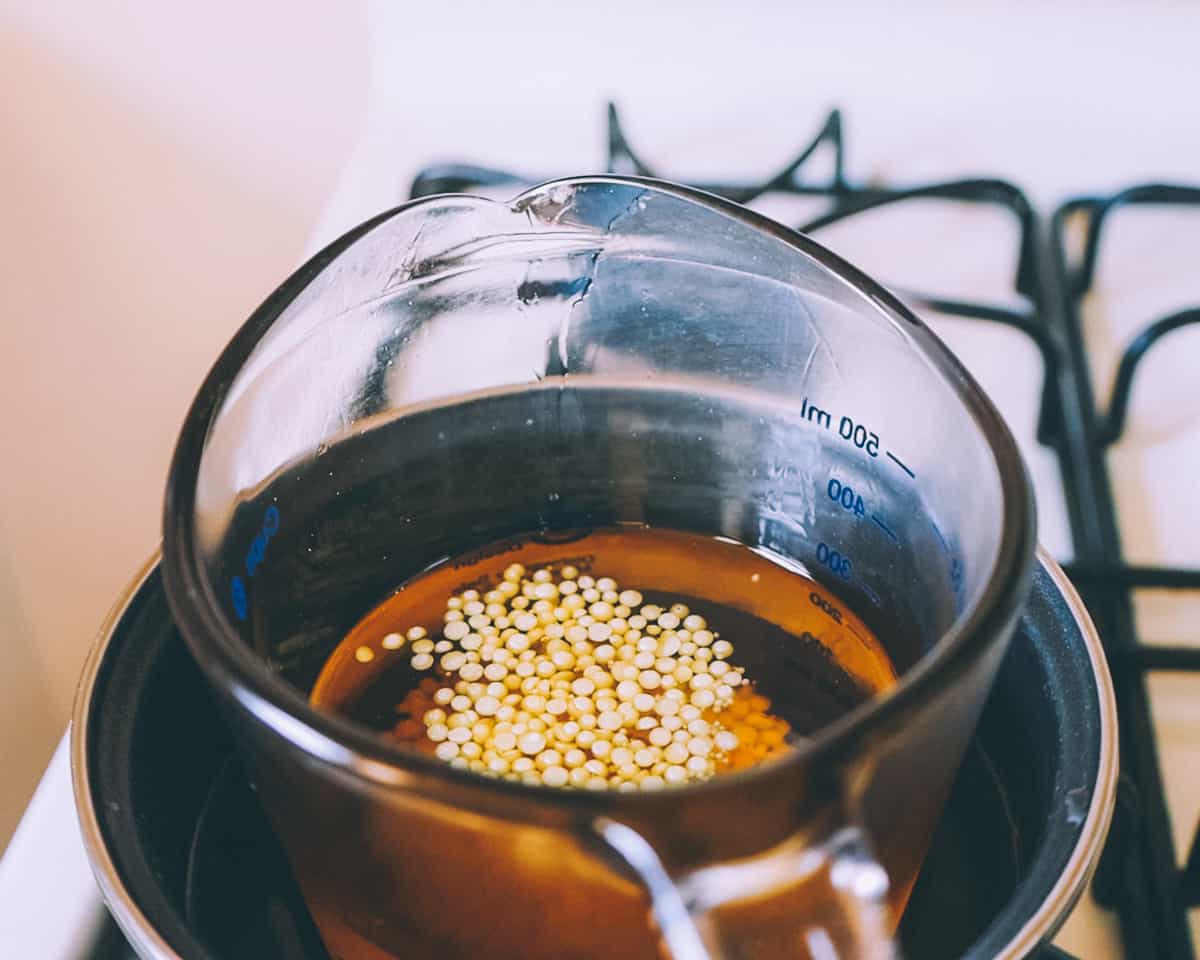
Heat until the beeswax melts completely into the oil.
Pour the hot water out of the blender and put the oil/beeswax mixture in.
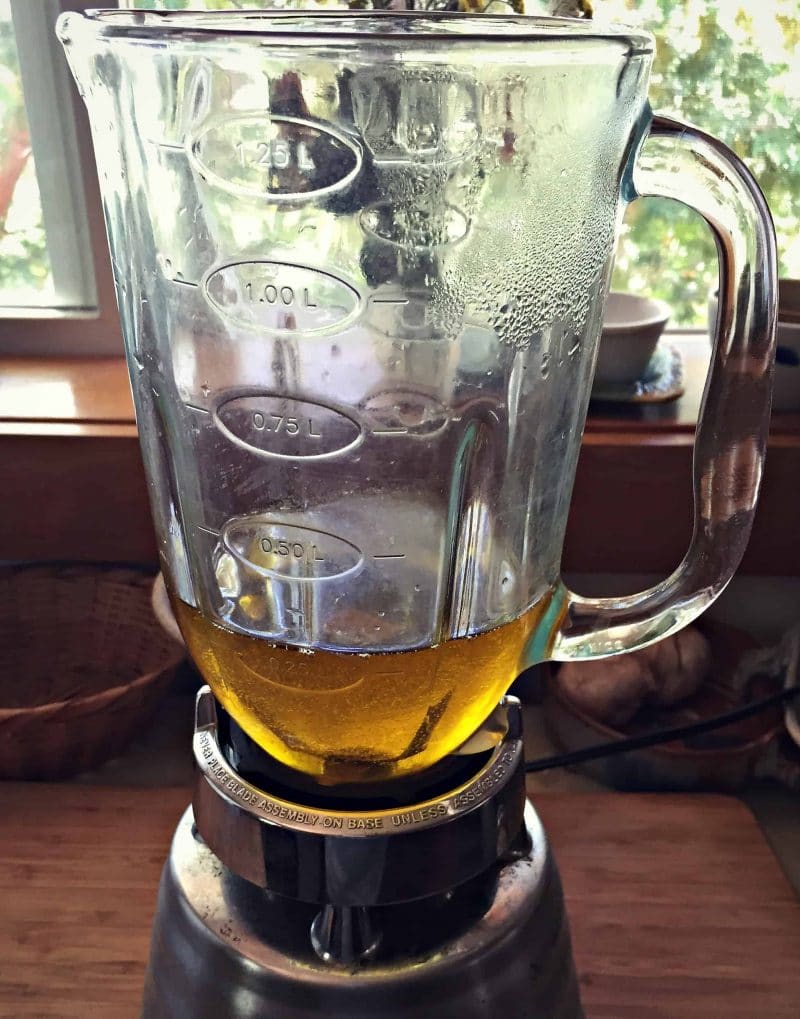
Cover the blender except for the hole that is used for drizzling liquids in. Turn it on and slowly drizzle the tepid water in. Make sure the water is tepid – not too hot or too cold.
It should become a creamy emulsification quite quickly! You may need to scrape down the sides of your blender once or twice to make sure all of the water gets incorporated.
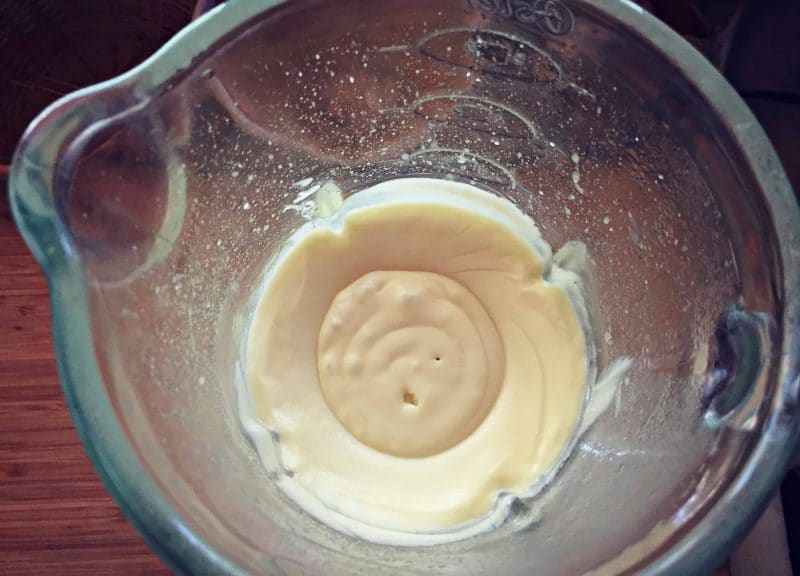
Let the cream cool a bit and then add the preservative and blend again to combine.
Pour the cream into containers, it will make about 2 cups total. Small glass jars or tins work well for this.
Let the cream set up for several hours before use.
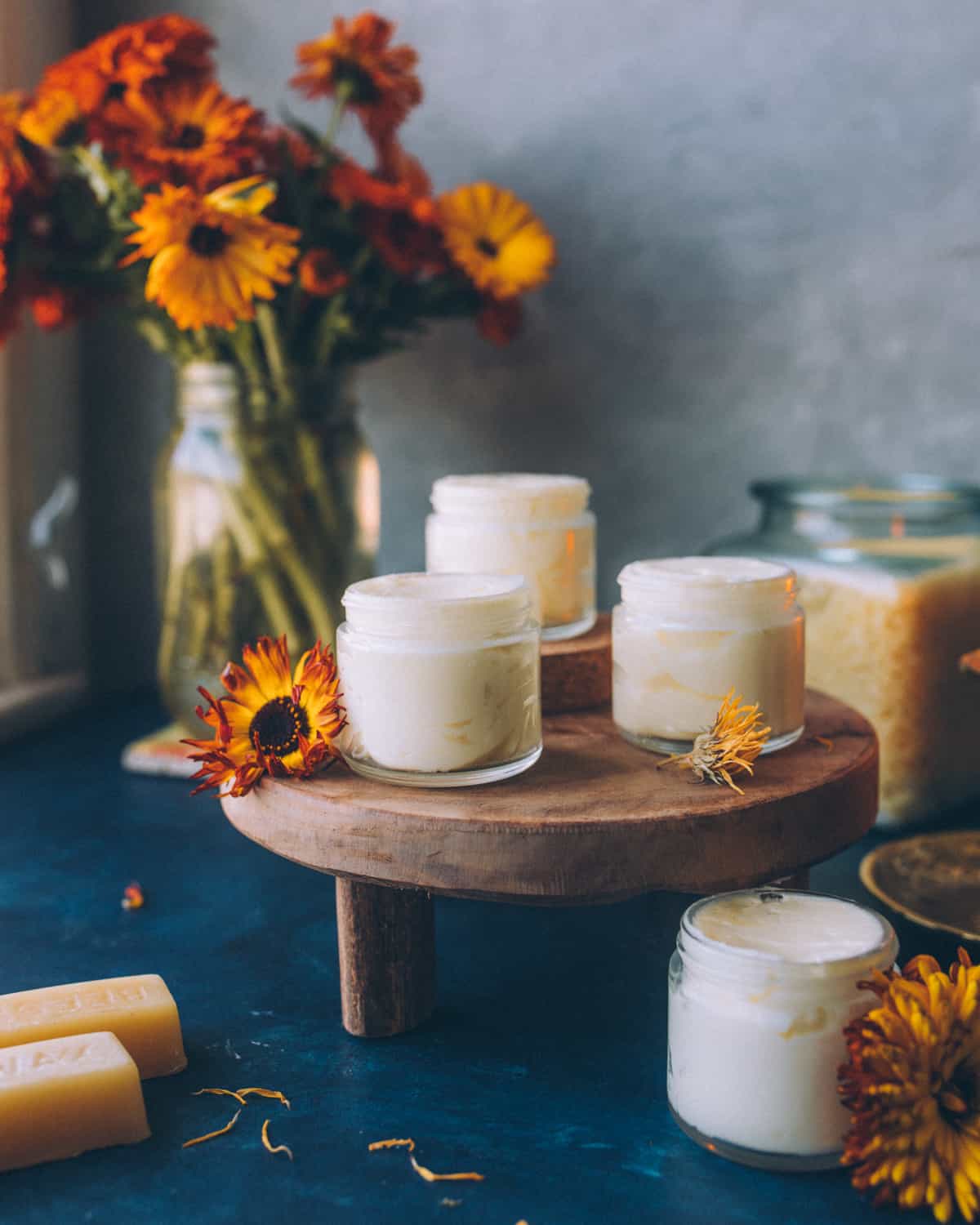
How to Use Calendula Cream
This calendula cream is so amazingly rich and luscious! It is perfect to use on very dry and even cracked skin, or even on minor wounds and scars.
It is better than any lotion that I’ve tried, plus it’s so nice to know that it has beneficial herbs and none of the yucky stuff that might be in the store bought cream. Makes me feel better!
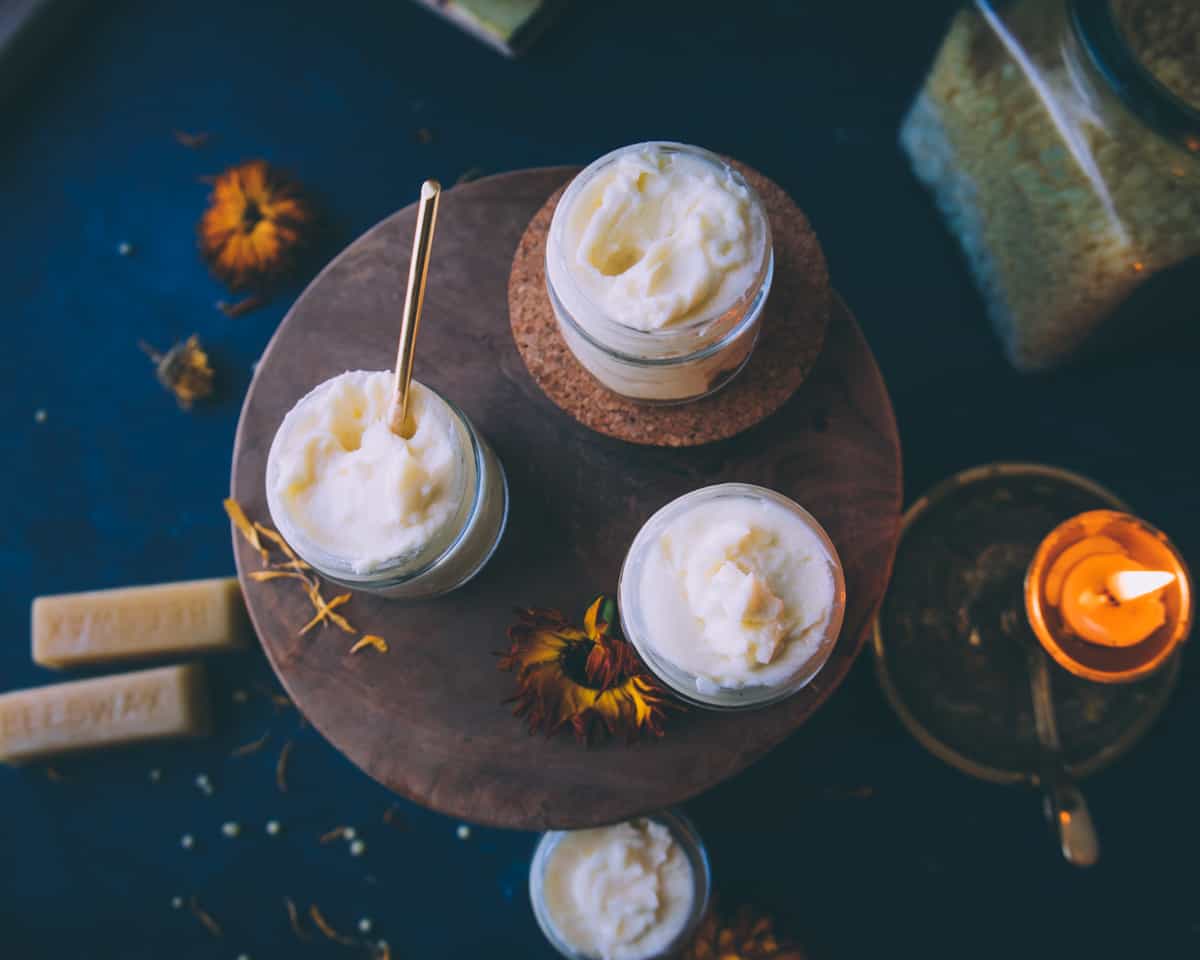
One thing is for sure, this calendula cream smells absolutely wonderful. This is definitely a recipe that I will make again and again. It’s super easy to make and is great for the skin.
Now that I’ve started on the path of making my own herbal remedies and natural healing products I really don’t see any reason to spend the money on buying these sorts of things.
Time to start making them yourself!
If you want to learn more about making homemade lotions and creams, I highly recommend Jan Berry’s (of the Nerdy Farm Wife) Handmade Lotions & Creams ebook collection!
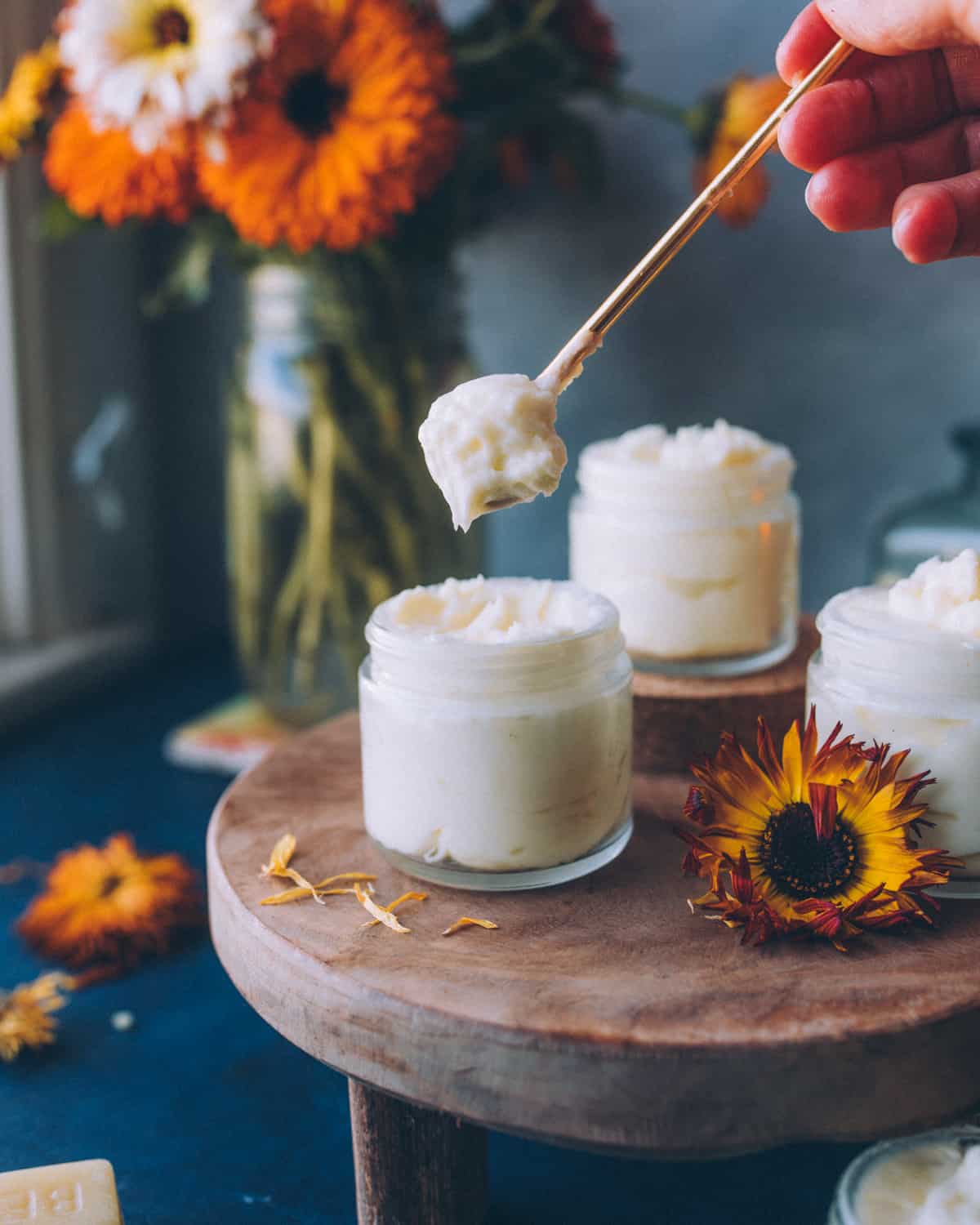
Do I need to use a preservative for calendula cream?
One thing to note, since this calendula cream is made with water it is best to add a preservative of some kind so that mold and other bacteria don’t grow.
While you could technically skip the preservative, it makes the cream quite perishable with a short shelf life of no more than a week. It also needs to be stored in the refrigerator between uses.
The Nerdy Farm Wife has a great post all about natural preservatives for homemade beauty products, so please check that out if you’d like to learn more. She also has a great list of 10 natural preservatives for homemade skincare.
I chose to use Leucidal Complete Protection which is a natural preservative that works well.
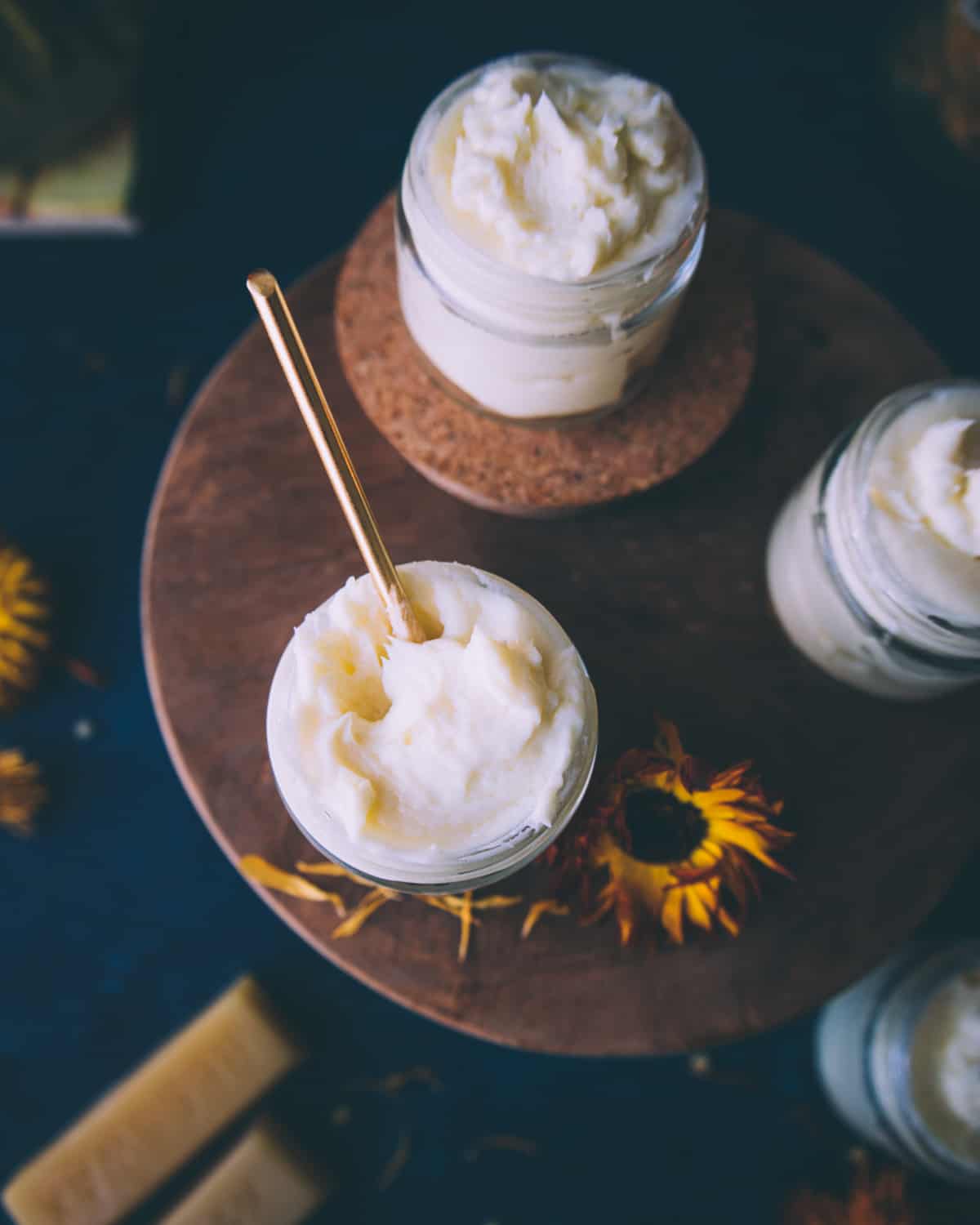
More Calendula Recipes
Explore more uses for lovely calendula flowers. Yes, they are even edible!
- 10 Ways to Use Calendula Herb-Infused Oil
- Calendula Lotion Bars
- Whipped Body Butter with Calendula
- Homemade Calendula Lip Balm
- Calendula Salve
- Diaper Rash Salve
- Calendula Soap
- Herbal Bath Salt with Calendula
- Calendula Shortbread Cookies
- Calendula Iced Tea
Calendula Cream
Ingredients
Calendula Infused Oil
- ½ cup dried calendula flowers
- 3/4 cup olive oil
- 1/4 cup coconut oil melted
Calendula Cream
- 1 cup calendula infused oil
- 1 ounce beeswax 4 Tbsp
- 1 cup tepid water
- 2 tsp Leucidal Complete Protection or another preservative (follow instructions on the bottle for amount to use)
Instructions
Calendula Infused Oil
- Combine the dried calendula flowers with the olive and coconut oils in a mason jar. Cover the jar with a lid and shake to mix well.
- Put the jar in a cool and dark place to infuse for 4-6 weeks.
- When you are ready to make the cream, strain the calendula flowers from the oil using a fine mesh sieve. If the coconut oil has solidified in the oil infusion, gently heat it by setting the jar in a pan of warm water to melt the oil before straining.
Calendula Cream
- Bring several cups of water in a pot to a boil. Put about 2 cups of the boiling water into a blender to preheat it.
- Create a makeshift double boiler by putting a smaller pan, bowl, or glass measuring cup in a larger pan that has an inch or two of water in it, and bring the water to a simmer.
- Measure out one cup of the calendula infused oil. Top off with extra olive oil if needed to make exactly one cup of oil.
- Put the oil into the double boiler. Add the beeswax to the oil and continue to heat until it has completely melted. A wooden skewer works well as a stirrer.
- Pour the hot water out of the blender and put the oil/beeswax mixture in.
- Cover the blender except for the hole that is used for drizzling liquids in. Turn it on and slowly drizzle the tepid water in. You may need to scrape down the sides of your blender once or twice to make sure all of the water gets incorporated.
- Let the cream cool a bit and then add the preservative and blend again to incorporate it.
- Pour the mixture into jars or tins.
- Let the cream set up for several hours before use.
Notes
- I adapted this recipe from the book Making It: Radical Home Ec for a Post Consumer World by Kelly Coyne and Erik Knutzen of Root Simple.
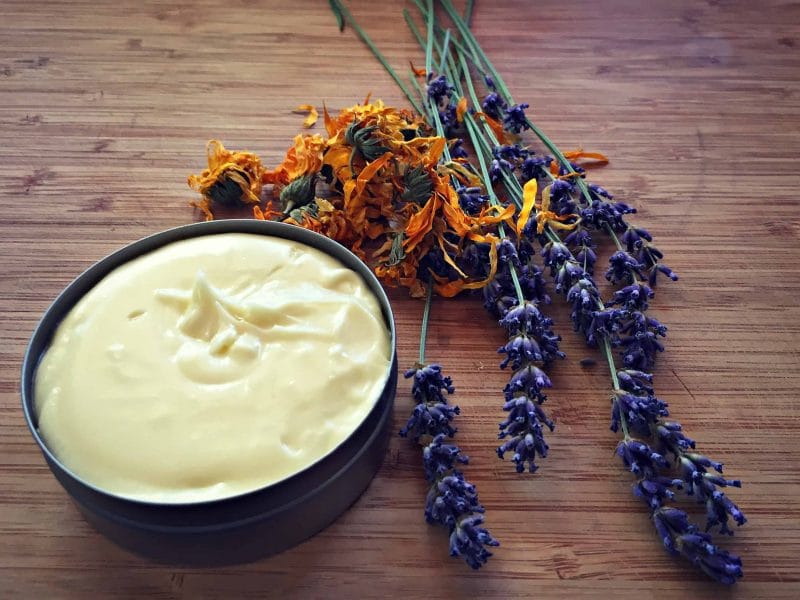

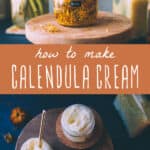


Do you have issues with the coconut oil being solid while making your infused oil? I want to follow your recipe, but I’m hesitant about the coconut oil! Thanks!
I use melted coconut oil and then make sure it’s somewhere warm enough that it says liquid. It’s not the end of the world if hardens a little.
hi, I wanting to make this cream for my kids. Tgey do not like the greasy feeling in there skin. When this cream is mafe is it greasy? if so how can i make it so its not greasy and soaks in quicly, still has all the medicinal purposes?
Hi Erin. Creams are typically less greasy to salves, so give it a shot!
What preservative do you use ?
Leucidal Complete Protection
Hi, I can’t wait to make this and the salve for my daughter who suffers really badly with eczema. Do I need to sterilise my small glass jars before putting the cream and salve in? Thanks.
As long as you wash them with hot, soapy water, that should be enough. Enjoy!
Does this not require an emulsifier? Do the water and oil not separate?
I didn’t use one and it didn’t separate.
I thought the same. How could it done if it don’t use emulsifier? And did we need to check the temperature of oil and water before mix them together? TiA
Thank you for this! I am having a hard time getting my utensils and bowls clean, though. Thee beeswax is persistent. Any ideas besides hot soapy water? Even the dishwasher did not get hot enough to clean.
Thanks, Colleen
Hi Colleen. I just use hot, soapy water. I wish there was a better way!
Hey Colleen, have you tried actually heating your bowls and utensils back up with soapy water in/on them? I put mine back into the double boiler pot with just soapy water in it until I’m sure the beeswax has melted again. Make sure to carefully splash the soapy water up the sides of the container once the wax has melted so it won’t stick again. Then just throw the soapy, waxy residue out and wash again as normal.
Can I use two tsp. grape seed extract as an alternate preservative?
Hi Jan. I haven’t tried it when grape seed extract, but I guess you could try it and see what happens.
Made this with an immersion blender and it worked really well, also added a little bit of rose essential oil and it smells really good with the calendula. Great recipe!
So glad you liked this recipe!
Could I sub cocoa butter for a vegan option?
Yes, that’s fine. Depending on which alternative you use, you may need to increase or decrease the amount.
I love calendula! What is the shelf life of the cream?
About six months, possibly longer refrigerated.
Hi, how much preservative do you use?
2 tsps. The complete recipe is at the bottom of the page.
Thank you Colleen for all your lovely gifts of recipes for healthy things . Love your site and enjoy all your emails. You are an amazing writer and your recipes and crafts are the best. Thanks again, please keep doing what you are obviously so naturally gifted at doing, writing, crafting and fermenting !!
Thank you, Shannon!!